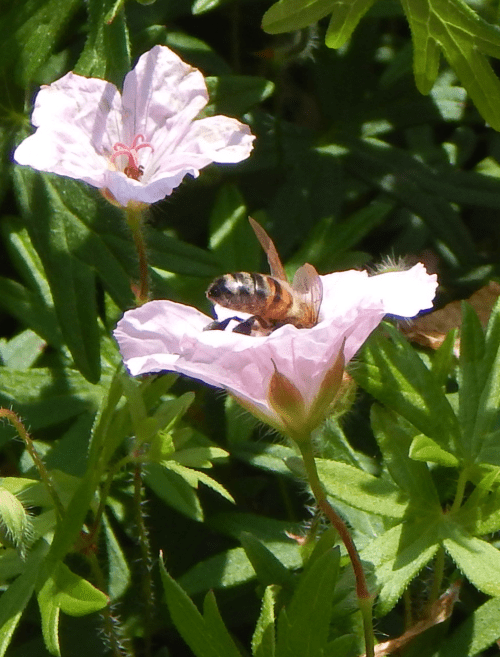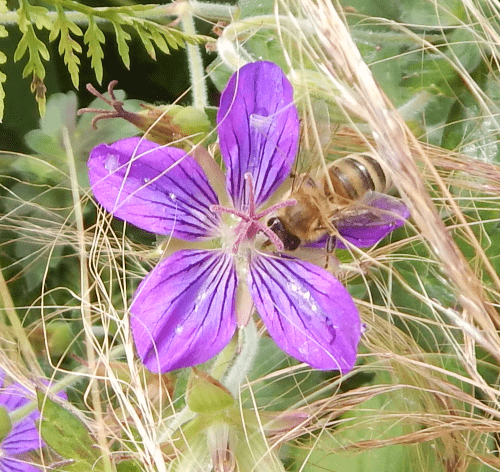Plant Hardy Geraniums For Bees
I would encourage everyone with a garden to plant hardy geraniums for bees.
Hardy geraniums are among my favourite plants, not only because so many different bee species visit the flowers, but because they are also very easy to care for.
Geraniums for bees in my garden
I have three varieties of hardy geranium in my garden, and if I had gaps to fill, I'd consider adding more.
Geranium sanguineum var. striatum - also known as 'striped bloody cranesbill
The low growing, pale pink geranium pictured below is Geranium sanguineum var. striatum - also known as 'striped bloody cranesbill'. It grows in the front garden on the rockery, and is useful for providing dense coverage. It provides long-lasting, cheerful flowers from June to August, and every year it attracts a variety of bee species.
 Common carder bumble bee foraging on Geranium sanguineum var. striatum.
Common carder bumble bee foraging on Geranium sanguineum var. striatum. Honey bee foraging on Geranium sanguineum var. striatum.
Honey bee foraging on Geranium sanguineum var. striatum.
Geranium 'Brookside' - cranesbill 'Brookside'
This geranium has rich purple petals, reddish veins and a paler centre. A variety of bee species love to forage on these pretty flowers, such as leafcutter bees.
 Leafcutter bee foraging on Geranium 'Brookside'.
Leafcutter bee foraging on Geranium 'Brookside'.It's also popular with honey bees and bumble bees.
It flowers from June to September, and dies back for winter. Fresh new growth appears the following year. You can prolong flowering easily by deadheading this plant.
 Red-tailed bumble bee foraging on Geranium 'Brookside'.
Red-tailed bumble bee foraging on Geranium 'Brookside'.I increased the number of colonies of this specimen by dividing the plant I had originally purchased in spring a couple of years or so after it had become well established.
One point I would make is that the flower stems of this geranium are about 50cm in length, and stand above the foliage. In my experience they are prone to being flattened by rain, without springing back up again. For this reason, I recommend it for underplanting suitable shrubs and bushes near the front of the flower border.
Geranium pretense 'Striatum' ('Splish-splash')
Another favourite with the bees in my garden is Geranium pratense 'Striatum' ('Splish-splash') - meadow cranesbill (similar to Geranium pratense 'Delft Blue'). This geranium has quite sturdy flower stems of about 60cm, and as you can see from the images below, the petals are white with lilac/mauve-blue 'splashes'. No two flower heads are the same, and they are quite striking. Again, this flower is popular with many bee species, such as red-tailed bumble bees, Bombus lapidarius.
 Red-tailed bumble bee on Geranium pretense 'Striatum' ('Splish-splash').
Red-tailed bumble bee on Geranium pretense 'Striatum' ('Splish-splash').Again, you can easily prolong flowering by deadheading the plant, so the bees could be visiting the flowers from May through to September. As with 'Brookside' above, this geranium dies back in winter, followed by new growth the following year, and you can also divide the plants in spring.
 Male orange legged furrow bee inside Geranium pretense 'Striatum' ('Splish-splash') flower.
Male orange legged furrow bee inside Geranium pretense 'Striatum' ('Splish-splash') flower.
Not in my garden, but popular with bees: Wlassov's cranesbill - Geranium wlassovianum
This is very similar to the wild 'sticky purple geranium', Geranium Viscosissimum. I don't have this in my garden. The photographs below were taken in the garden of a stately home. It was very popular with bees, and is another geranium plant I would consider adding to my flower border.
 Honey bee on Wlassov's cranesbill -
Geranium wlassovianum.
Honey bee on Wlassov's cranesbill -
Geranium wlassovianum.Again, the plant can be propagated by division in spring. Flowers from June through to September.
More articles about bees and plants
- Bees And Brambles: The Value Of Brambles To Bees Also known as blackberry bush, research shows each bramble flower secretes lots of nectar for bees!
- Bees And Bee Balm Bee Balm (Monarda) - also known as 'Bergamot) is a herbaceous perennial which is attractive for bees.
- 30 Fantastic Garden Flowers For Bees Flowering plant recommendations for the perfect bee garden.
- Bees love lupins – but so do slugs and snails, so what can you do? Here's a way to protect your lupins....using garlic!
- Plant Oregano For Bees (Marjoram) It's rich in nectar, and attracts bees, butterflies and hoverflies in summer. Here's how to plant it.
- Fennel Pollen And Nectar Bees love fennel! How to grow it, gather it, and the many uses of fennel seeds and pollen.